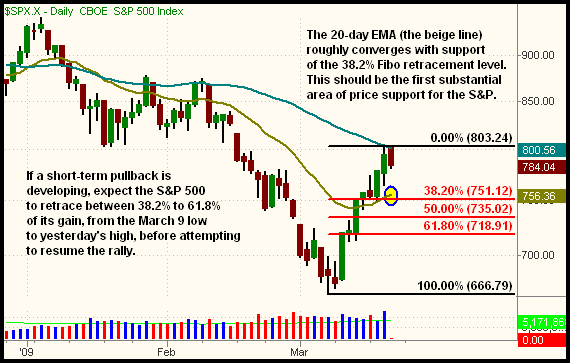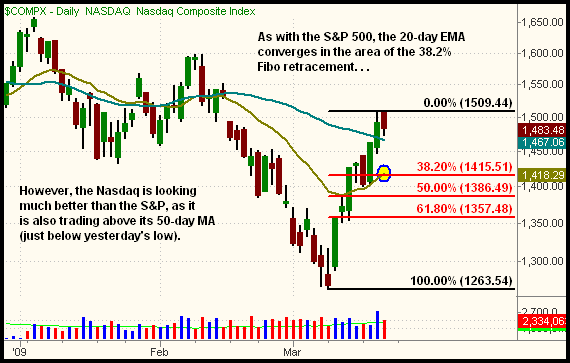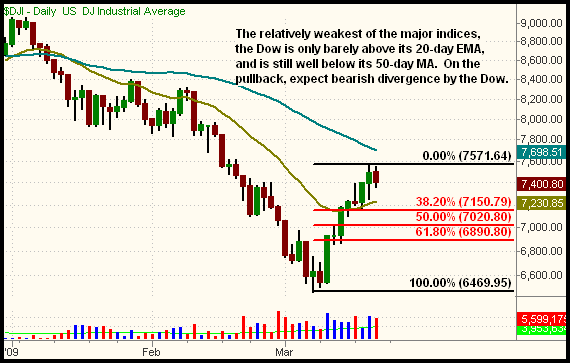| The Wagner Daily ETF Report For March 20 |
| By Deron Wagner |
Published
03/20/2009
|
Stocks
|
Unrated
|
|
|
|
The Wagner Daily ETF Report For March 20
As anticipated, the S&P 500's touch of its 50-day moving average in the previous session gave the broad market a convenient reason to pause yesterday, but the moderate losses occurred on lighter volume. Stocks initially gapped to open near the prior day's highs, but drifted back down throughout the morning. A very tight, sideways range dominated the subsequent afternoon trading session. The Nasdaq Composite eased 0.5%, the Dow Jones Industrial Average 1.2%, and the S&P 500 1.3%. The small-cap Russell 2000 slipped 1.1% and the S&P Midcap 400 lost 0.6%. All the major indices closed near the bottom of their intraday ranges.
Lighter turnover across the board enabled the main stock market indexes to avert the label of a bearish "distribution day." Total volume in the NYSE was 6% lower than the previous day's level, while volume in the Nasdaq receded 17%. Considering Wednesday's trading registered way above average levels, it would have been a bearish sign of "churning" if volume had spiked even higher yesterday. Market internals were only marginally negative. In both the NYSE and Nasdaq, declining volume edged out advancing volume by a margin of approximately 3 to 2.
Yesterday's pullback, triggered by resistance of the 50-day MA on the S&P 500, may have set the market up for a short-term correction from its recent lows. A further retracement would enable traders and investors to jump into new long positions with better reward-risk ratios than at current prices, but how far should we expect the major indices to correct? For smooth and steady uptrends such as the present, one of the best and most accurate technical analysis tools for predicting the depth of a pullback is the use of Fibonacci retracements. Below are daily charts of the S&P 500, Nasdaq Composite, and Dow Jones Industrial Average. On each, we've applied the main Fibonacci retracement lines of 38.2%, 50%, and 61.8%. You may want to set alerts on your trading software, so that you're instantly notified if one of the major indices touches its 38.2% retracement level:



Most likely, the main stock market indexes will retrace down to anywhere between the 38.2% to 61.8% levels (roughly one-third to two-thirds of their gains from their March 9 lows to this week's highs), but it's impossible to predict exactly how deep the retracement will become. However, the true legitimacy of the current rally will make itself known, as the shallower the retracement, the stronger the market. Strong markets with clear bull dominance will typically retrace to just the 38.2% level (or even less) before ripping to set a new "higher high." A really bullish market could merely trade sideways for a week or two, allowing the 20-day EMAs to catch up to the price, rather than even retracing off its highs. Conversely, shaky markets with less bullish conviction will frequently retrace down to the 61.8% level before heading back up. If, by some chance, the major indices happen to violate their 61.8% levels, all bets are off on the long side of the market because such action could quickly lead to a test of the March 9 lows.
Note that today is quarterly "quadruple witching" options expiration, the day on which contracts for stock options, stock index futures, stock index options, and single stock futures simultaneously expire. Typically, "quadruple witching" is marked by erratic movement in the stock market, caused by market participants taking large positions to jockey around their contract holdings. As a general rule, we usually avoid entering new positions on "quadruple witching" days because the session is often marked by fakeout moves that fail to follow through the following day. As such, we'll simply be taking a "set it and forget it" approach to stops on our ETF positions, while likely delaying new trade entries until after the weekend. Let's let this developing pullback play out in the coming days, while scanning for the next buy candidates if the retracement turns out to be short-lived.
Open ETF positions:
Long - QLD, SLV, USO, UGA
Short - (none)
Deron Wagner is the Founder and Head Trader of both Morpheus Capital LP, a U.S. hedge fund, and Morpheus Trading Group, a trader education firm launched in 2001 that provides daily technical analysis of the leading ETFs and stocks. For a free trial to the full version of The Wagner Daily or to learn about Wagner's other services, visit MorpheusTrading.com or send an e-mail to deron@morpheustrading.com.
|